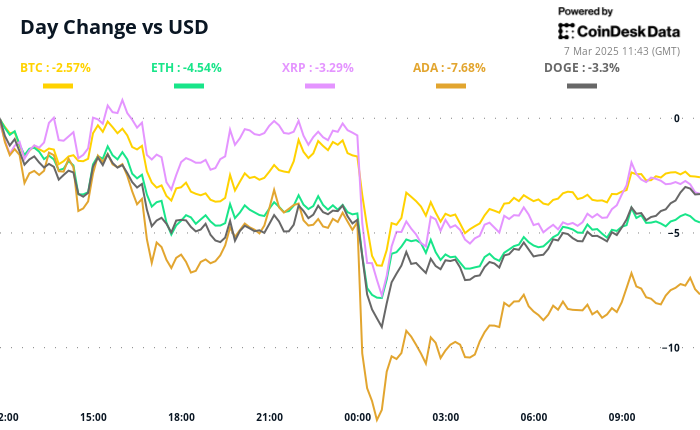Disappointment at the White House Crypto Summit
The highly anticipated White House Crypto Summit held on Friday left cryptocurrency traders feeling let down, resulting in significant declines for altcoins like XRP, Cardano’s ADA, and Solana’s SOL. These cryptocurrencies fell more steeply than the market leader, Bitcoin (BTC), which managed to maintain a relatively stable position.
High Hopes for a Game-Changing Announcement
Investors had high expectations for bold initiatives from President Donald Trump, particularly regarding the establishment of a U.S. strategic crypto reserve that would prominently include major altcoins. However, the summit concluded with a muted response, unveiling only a framework for stablecoin legislation expected before August and vague promises of a lighter regulatory approach. These announcements failed to ignite the market as many had hoped.
Trump’s Take on Bitcoin and Market Reactions
During the summit, Trump expressed his discontent over the federal government’s decision to sell a substantial amount of its seized Bitcoin, describing it as “foolish.” He emphasized a colloquial rule: “never sell your bitcoin.”
As for the market reactions, XRP saw a decline of 3.5% over the last 24 hours, dropping to approximately $2.4 from a high of $2.98 earlier in the week—a nearly 20% drop from its peak following Trump’s initial reserve announcement. Cardano’s ADA fell more than 5%, while Solana’s SOL lost 4%, trading around $138 during the Saturday afternoon hours in Asia.
Bitcoin’s Relative Resilience
In contrast to the altcoins, Bitcoin held its ground better, trading at $86,000 and experiencing a decline of only 2.5% in the past day. This relative stability highlights the significant disparity in market performance between Bitcoin and the altcoins following the summit.
The Summit’s Promised Impact and Clarifications
The event, led by Trump’s AI & Crypto Czar David Sacks, was positioned as a pivotal moment in U.S. crypto policy. However, Sacks clarified that Trump’s mention of five cryptocurrencies as part of the strategic reserve was merely illustrative and not a concrete commitment. This clarification dampened the optimism that had prevailed earlier in the week, when Trump’s posts on Truth Social had sparked a massive rally, with some major cryptocurrencies surging by as much as 60%.
Potential Global Implications of U.S. Policy
Despite the disappointment, the potential embracing of Bitcoin by the U.S. could lead other countries to follow suit, creating a ripple effect that might serve as bullish catalysts in the months to come.
Vincent Chok, CEO of First Digital, commented on this development, stating, “The U.S.’ prioritization of Bitcoin as a reserve asset not only legitimizes its status as ‘digital gold’ but also sets a precedent that could accelerate regulatory frameworks and drive institutional adoption worldwide.” He further noted that this could inspire other nations to establish their own national strategic stockpiles, fostering increased institutional participation and liquidity in the decentralized finance market, extending interest beyond Bitcoin to other digital assets like stablecoins.
In summary, while the White House Crypto Summit fell short of expectations, the long-term implications of U.S. crypto policy could still influence the global landscape significantly.



